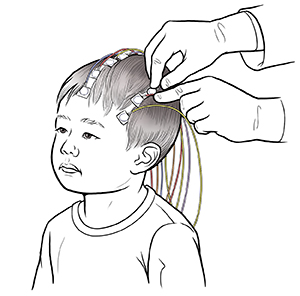When Your Child Needs an Electroencephalogram (EEG)
When Your Child Needs an Electroencephalogram (EEG)

Before the test
Follow all instructions given by the technologist and your child’s healthcare provider to prepare your child for the test:
Normally, an EEG is performed while your child is awake. Sometimes, recording must also be done while your child is drowsy or asleep. In these cases, you’ll be asked to reduce the amount of sleep your child gets before the test. This may mean your child has to stay up later and get up earlier than usual. Sometimes a flashing light (stroboscope) might be used for a few minutes during the EEG recording.
Don't use any hairstyling products (such as oils) in your child’s hair before the test. Any hair extensions or braids should also be removed. These may interfere with the placement of the electrodes during the test.
If your child is taking any medicines, let the healthcare provider know before the test. Certain medicines may need to be stopped if they can interfere with test results.
Let the technologist know
For your child’s safety and the success of the test, let the technologist know if your child:
Takes any medicines
Has a history of seizures
Has any health problems
During the test
An EEG is done by a trained technologist. During the test, the electrical activity of your child’s brain is recorded on a computer or printed on paper. In addition, a video camera may be used to record your child’s physical activity. You can stay with your child in the testing room. Your child can bring a favorite toy, such as a stuffed animal, for comfort.
The technologist begins by placing the electrodes on your child’s scalp. A special glue, paste, or water-based gel is used to help keep the electrodes in place. The glue's smell can be very strong and unpleasant. But it is not painful.
During the test, your child lies down on a hospital bed. If your child is drowsy or asleep for part of the test, the technologist may actively wake your child at a later point.
The technologist may ask your child to do some simple commands, such as the following:
Open and close the eyes.
Breathe fast and deep (hyperventilate). For young children, blowing on a pinwheel may help with this task.
Sense a bright flashing light through closed eyes.
Go to sleep.
If you notice signs that your child may be having a spell or seizure, tell the technologist right away.
After the test
Here is what to expect:
Once the test is complete, the electrodes are removed. Any glue, paste, or gel is cleaned from the scalp.
Unless told not to, your child can return to his or her normal routine.
Schedule a follow-up appointment with your child’s healthcare provider to review the results of the test.
Let your healthcare provider know if symptoms or seizures worsen after the test.
Helping your child prepare
Many hospitals have people trained in helping children cope with their medical care or hospital experience. These people are often called child life specialists. Check with your child’s healthcare provider if child life programs or other similar services are available for your child. There are also things you can do to help your child prepare for a test or procedure. How best to do this depends on your child’s needs. Start with the tips below:
Use short and simple words to describe the test to your child and why it’s being done. Younger children tend to have a short attention span, so do this just before the test. Older children can be given more time to understand the test in advance.
Tell your child what to expect in the hospital during the test. For instance, you could talk about who will be doing the test and what the hospital room will look like.
Make sure your child knows which body parts will be involved in the test.
As best you can, describe how the test will feel. For instance, an electrode may be placed on the skin. The electrode is round and may feel sticky.
Let your child ask questions. Answer these questions truthfully. Your child may feel nervous or afraid. He or she may even cry. Let your child know that you’ll be nearby during the test.
Use play when telling your child about the test, if appropriate. With younger children, this can involve role-playing with a child’s favorite toy or object. With older children, it may help to read books or show pictures of what happens during the test.
Updated:
January 01, 2018
Sources:
Patient information: Seizures in children (Beyond the Basics). UpToDate
Reviewed By:
Bass, Pat F. III, MD, MPH,Image reviewed by StayWell medical illustration team.,Jasmin, Luc, MD